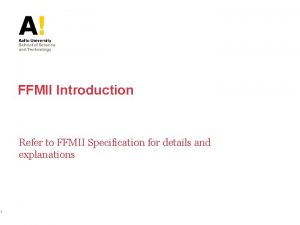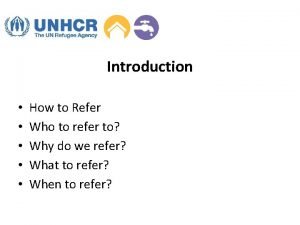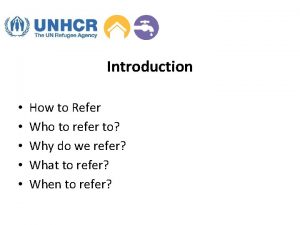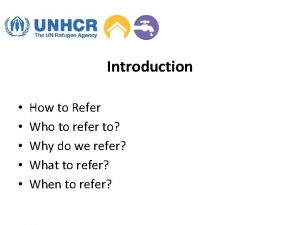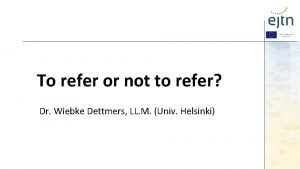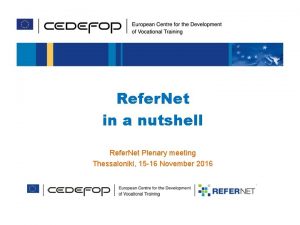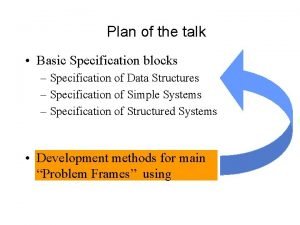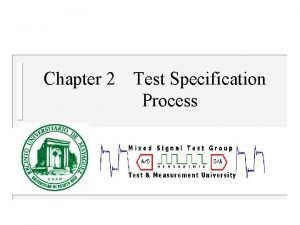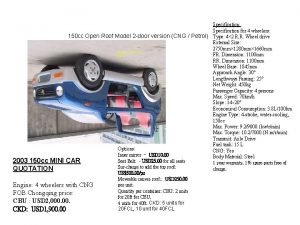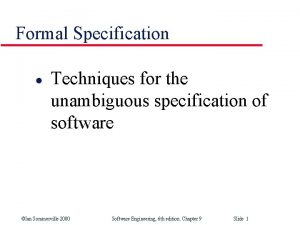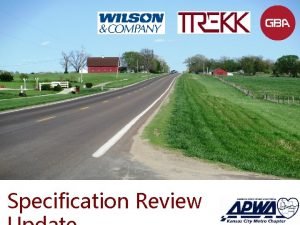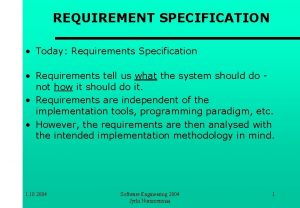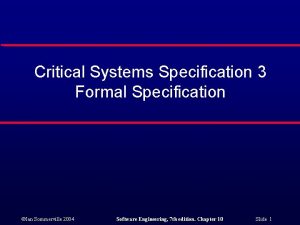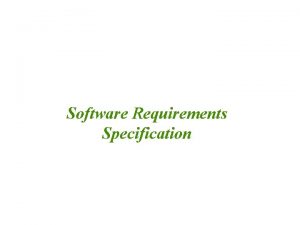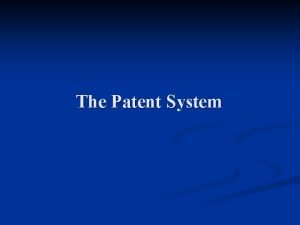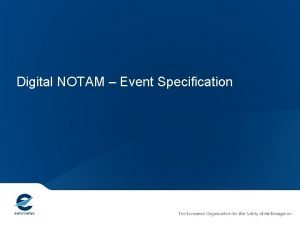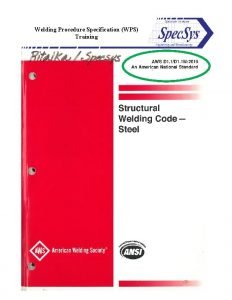1 FFMII Introduction Refer to FFMII Specification for


























- Slides: 26

1 FFMII Introduction Refer to FFMII Specification for details and explanations

Field Force Management Integration Interface FFMII provides a flexible interface between ERMS and FFMS for the purpose of work request modeling, exchange, and collection of data from the field. Information carried with work requests, work request structure (work-flow) and data to be collected can all be defined dynamically ‘as data’. This data driven architecture makes FFMII very flexible and adaptable to numerous industries Rossum, NSN, Click. Software Technologies, Aalto, Newelo, Pajat Management 2

Design Goals & Characteristics • • • Applicability across domains and use cases Technical scalability Feature scalability Expression accuracy and user guidance Reliable message exchange Deployment adaptability and technology neutrality

Example Use Case: Telecom installation • Installation company receives installation jobs from several telecom operators • Work Request structure and reporting requirements vary – Order details, instructions, process flow, products and parts – Resolution codes, on-site sales and exception reporting • Single job may involve several locations – distribution points, cross-connections, end-user premises • Single installation may be split to several assignees • Information sharing among Field Force • Field-Initiated Requests – find available work, reserve job to me, initiate new job 4

Example: Data Content and Structure Work Request Data Forms Header Your. Comm Installation 012344 32 Connection Street, Somecity Overview Instructions Type: ADSL Installation Target Time: 07/31/12 12: 34 Connection ID: CI 333256523 Bandwidth: 12/4 Mbps Connection Point A: 1234. 13. 324. 1 Connection Point B: 1553. 123. 6 Subscriber Name: John Smith Address: 32 Conection Street, Somecity Phone: 555 -0199 -777 Products Product Copper Connect ADSL Installation Quantity 1 1 5 Route: BSC 13650/0 ADSLFR ADSL 72_AD_03 -7 SOC 0/100 PVC VLAN_12_VLAN SOC/00101/1 - K 32/2/51 SOC/27/1 - V 68/1/9 C … Network Map: NMSome. City 72. PDF

Example: Activities and Work Flow Work Request Activities Connect Assignee: John Williams Location: 17 Apple Street Begin at: 7/31/12 08: 00 Suspended Suspend New Start Resume Ongoing Ready Completed Dependent on state Install Assignee: Dorothy Hayes Location: 32 Connection Street Appointment: 10: 00 – 12: 00 New Start Ongoing Ready Completed Suspended Input Form on Ready Device Class: [Enumerated code] Resolution: [Enumerated code] SLA Breach [Enabled if current time past SLA target] Breach Reason: [Enumerated code] Explanation: [String, non-empty] 6

Highlighted Features • Multi-tenancy • Data-centric design • Work Request Management – Dynamically specified data content and structure – Multiple Activities with dynamic work flow and dependencies • Field-Initiated Requests – Dynamically specified operations and data content • Reference Data Management – Unified interface for managing reference information – Field Force, Work Types, Field-Initiated Request operations, shared Work Request data (code sets, attachments, etc) 7

FFMII overview Non-standard track: Field Force Management Integration Interface Requirements Version 1. 0 • • • business drivers business use cases, and high level features requirements Standard track: 1) Field Force Management Integration Interface Specifications Version 1. 0 FFMII Protocol Binding: SOAP over HTTP (Web Service) 2) • • WSDL description of the FFMII for Implementation and Manager interfaces XML Schema type definitions for the associated XML namespaces 8 FFMII Specifications: structure & main contents

Flexible integration topologies • Simple topology: a single Manager and a single Implementation interacting • Distributed work realization: A single Manager interacting with several Implementations for communicating with distinct groups of field personnel • Shared Field Force: multiple Managers interacting with a single Implementation • Multi-Paradigm: multiple Managers interacting with a single Implementation Multi-paradigm integration topology (example) Manager Shared field force Distributed work realization Implementation 9 Implementation

Domain Model (main topics of FFMII ) FFMII Domain Model Task Work Request Work Type Specification Activity Step Assignee Schedule Data Form State Action Work Request Status Change Notification Work Request Status Record Topical Notification Topical Inquiry Field Initiated Request Dependency Reference Data

Domain Model (Work Request) FFMII Domain Model Task Work Request Work Type Specification Activity Step Assignee Schedule Data Form State Action Work Request Status Change Notification Work Request Status Record Topical Notification Topical Inquiry Field Initiated Request Dependency Reference Data

Work Request Manager produces series of self-contained Work Requests representing Tasks related to Field Works. Each Task is to be performed by one or more Assignees belonging to the addressable Field Force. A Manager communicates with one or more Implementations over the FFMII interface to make the planned Tasks accessible to corresponding Assignees. 12

Domain Model (Work Type Specification) FFMII Domain Model Task Work Request Work Type Specification Activity Step Assignee Schedule Data Form State Action Work Request Status Change Notification Work Request Status Record Topical Notification Topical Inquiry Field Initiated Request Dependency Reference Data

Work type Specification structure A Work Type Specification (WTS) describes content and structure of a Work Request 14

Relationship of Steps, Actions and States within an Activity A combination of States, Steps and Actions form an Activity State Model. FFMII interface does not prescribe or imply usage of any specific Activity State Model in order to remain neutral with respect to types of Task a Work Request may represent. In this example, the On. Site state requires the Assignee to decide whether the Task may be fulfilled by repairing the customer's equipment, or whether it is necessary to replace the equipment with a new unit. Action: Transition to On. Site Action: Repair Action: Transition to X-Finalize Therefore there are two possible actions leading from Step 2, and both of them are enabled so that the Assignee may select either of them (enabling conditions aren't visualized in this diagram). If the Assignee chooses the Replace action, the action leads to Step 4. In this example, replacement requires approval, so the dashed action transfers the task to an Inactive state, pushing the current State into the State Stack. At that point, the other action leading from Step 4 is not enabled, due to an enabling condition which depends on receiving the approval. Once the approval arrives, the next action pops the State Stack to return to the On. Site state. Action: Replace Action: Transition to X-Finalize Note: a more complete scenario would probably also include action that should lead from Step 5, for handling the case when approval is not granted, possibly leading to another State in the Closed category which reflects cancellation of the Work Request. Action: Transition to Completed 15

Example: Activity State Model with Dependencies Activities MAY have dependencies on other Activities being in specific States. Activity-Enabling dependencies and Action-Enabling dependencies are specified as Boolean expressions referred to as Conditions. Activity 1 is not made available to the Assignee until Activity 3 is in “Completed” State. Additionally, while at the “New” Step, Activity 1 won’t be allowed to proceed towards the next Step, “Traveling to Site”, unless Activity 2 is at any Step associated with the State “Ongoing”. 16

Domain Model (Data Form) FFMII Domain Model Task Work Request Work Type Specification Activity Step Assignee Schedule Data Form State Action Work Request Status Change Notification Work Request Status Record Topical Notification Topical Inquiry Field Initiated Request Dependency Reference Data

Data forms Data Forms are used to model dynamically specified structured information. Data Forms are used, for example, for the purpose of defining Work Request header, overview and instructions, Step level instructions and user input. 18

Data Element Specification • Data Element Specification is an abstraction that supports a common set of attributes for all sub-classes of Data Element Specifications 19

Data Element Types • • Simple data field: Data Field Specification Matrix of Data: Data Matrix Specification Attachments: Data Attachment Specification Grouping of possibly nested Data Elements: Data Group Specification 20

Domain Model (Work Request Status Record) FFMII Domain Model Task Work Request Work Type Specification Activity Step Assignee Schedule Data Form State Action Work Request Status Change Notification Work Request Status Record Topical Notification Topical Inquiry Field Initiated Request Dependency Reference Data

Work Request Status Record reflects state changes of Work Request after it has been received by the Implementation. An Implementation MUST maintain one Work Request Status Record per each Work Request 22

Domain Model (Reference Data) FFMII Domain Model Task Work Request Work Type Specification Activity Step Assignee Schedule Data Form State Action Work Request Status Change Notification Work Request Status Record Topical Notification Topical Inquiry Field Initiated Request Dependency Reference Data

Reference Data An Implementation MAY provide means for the Manager to establish custom data repositories with arbitrary content “Reference Data” that MAY be used for input value selection, lookup of display values or content validation in Work Requests. An Implementation MAY also provide access to system repositories providing access to selected data on Implementation side, such as Assignee identities and alike. 24

Domain Model (Field Initiated Request) FFMII Domain Model Task Work Request Work Type Specification Activity Step Assignee Schedule Data Form State Action Work Request Status Change Notification Work Request Status Record Topical Notification Topical Inquiry Field Initiated Request Dependency Reference Data

Field-Initiated Request (FIR) is a request initiated by an Assignee and dispatched as a structured message from Implementation to Manager. It is intended for making requests or reporting information outside the usual Activity work flow, such as requesting activation or reset of a specific device, reporting absence of the Assignee, or requesting additional work for the Assignee. 26
 Upper specification limit and lower specification limit
Upper specification limit and lower specification limit Natural variations operations management
Natural variations operations management Fspos vägledning för kontinuitetshantering
Fspos vägledning för kontinuitetshantering Typiska novell drag
Typiska novell drag Nationell inriktning för artificiell intelligens
Nationell inriktning för artificiell intelligens Ekologiskt fotavtryck
Ekologiskt fotavtryck Varför kallas perioden 1918-1939 för mellankrigstiden?
Varför kallas perioden 1918-1939 för mellankrigstiden? En lathund för arbete med kontinuitetshantering
En lathund för arbete med kontinuitetshantering Kassaregister ideell förening
Kassaregister ideell förening Tidböcker
Tidböcker Sura för anatom
Sura för anatom Förklara densitet för barn
Förklara densitet för barn Datorkunskap för nybörjare
Datorkunskap för nybörjare Stig kerman
Stig kerman Att skriva en debattartikel
Att skriva en debattartikel Delegerande ledarskap
Delegerande ledarskap Nyckelkompetenser för livslångt lärande
Nyckelkompetenser för livslångt lärande Påbyggnader för flakfordon
Påbyggnader för flakfordon Kraft per area
Kraft per area Svenskt ramverk för digital samverkan
Svenskt ramverk för digital samverkan Kyssande vind analys
Kyssande vind analys Presentera för publik crossboss
Presentera för publik crossboss Vad är ett minoritetsspråk
Vad är ett minoritetsspråk Plats för toran ark
Plats för toran ark Treserva lathund
Treserva lathund Luftstrupen för medicinare
Luftstrupen för medicinare Claes martinsson
Claes martinsson



























